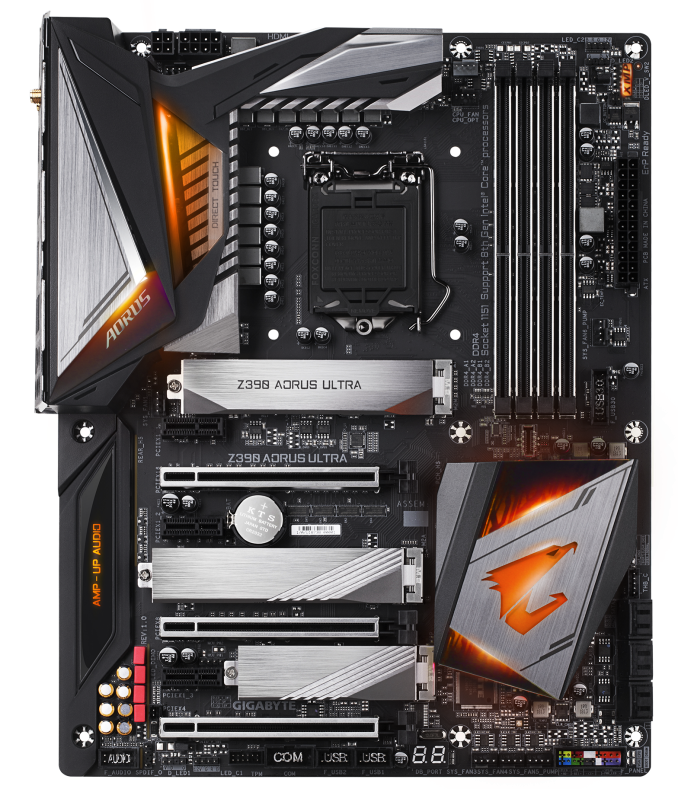Intel Z390 Motherboard Overview: 50+ Motherboards Analyzed
by Ian Cutress & Gavin Bonshor on October 8, 2018 10:53 AM EST- Posted in
- Motherboards
- Intel
- MSI
- Gigabyte
- ASRock
- EVGA
- Asus
- NZXT
- Supermicro
- Z390
GIGABYTE Z390 Aorus Ultra
As GIGABYTE has moved away from their numbering scheme and elected to use a more prominent gaming scheme, the previous Z370 Aorus Gaming 5 which sat in the mid-range of GIGABYTEs Intel range has been replaced by the Z390 Aorus Ultra. Aesthetically not much has changed as both models have integrated RGB LED lighting at various points across the board including the power delivery and chipset heatsinks and the Z390 does include a total of (insert) RGB headers to further expand the RGB capabilities of the board. Just like the Gaming 5, the Z390 Aorus Ultra has integrated 802.11ac Wi-Fi on top of a single LAN port so users can get the best of both worlds when connecting to a network. GIGABYTE also advertises a 13-phase VRM (12+1) so there should be plenty of headroom available for users looking to overclock the new 9th generation Intel processors.
The Z390 Aorus Ultra shares similar characteristics as the Z370 Gaming 5 such as three full-length PCIe 3.0 slots which operate at x16, x8 and x4 from top to bottom respectively. GIGABYTE has upgraded the previous board as the Z390 Aorus Ultra now has metal slot protection on all of the full-length PCIe 3.0 slots. Also included on the board is three PCIe 3.0 x1 slots.
While both the Z370 Aorus Gaming 5 and the new Z390 Aorus Ultra has three PCIe 3.0 x4/2 M.2 slots, all three slots now include a dedicated M.2 heatsink to aid in heat dissipation on the newer Z390 option. The board also makes use of six SATA slots with support for RAID 0, 1, 5 and 10 arrays. Focusing on memory, the Z390 Aorus Ultra has compatibility with DDR4-4133 RAM and up to a maximum supported capacity of 64 GB across four RAM slots.
On the rear panel, there are three USB 3.1 Gen2 Type-A, one USB 3.1 Gen2 Type-C and four USB 2.0 ports. Like the Z390 Aorus Master, there are also two USB 3.0 Type-A ports marked with GIGABYTE's DAC-UP audio boost technology. The Z390 Aorus Ultra has support for 2T2R Wave 2 802.11ac wireless networking and the single LAN port is controlled by an Intel I219V Gigabit networking controller. A single HDMI video output is featured for users looking to utilize the integrated graphics on supported 8th and 9th generation Intel processors and the onboard audio which consists of five 3.5 mm audio jacks and an S/PDIF optical output are controlled by a Realtek ALC1220-VB HD audio codec.
The GIGABYTE Z390 Aorus Ultra is a mid-high end Z390 option which costs $250 aimed towards gamers and enthusiasts looking to make use of multi-graphics card configurations and multiple M.2 storage devices with each slot garnering support for NVMe based drives. A handy LED debugger is also featured meaning users looking to overclock their processors have a handy method of diagnosing failed overclocks as well as POST related issues.












79 Comments
View All Comments
DanTMWTMP - Thursday, October 11, 2018 - link
Are they ALL made in China? What happened to the ones made in Taiwan from a few gens ago? :/gavbon - Friday, October 12, 2018 - link
Unfortunately, I cannot confirm this. The ASRock Z390 Taichi I have in my hands says 'designed in Taipei', but that's about it.Nagorak - Sunday, October 14, 2018 - link
Gigabyte apparently has a factory in Taiwan. It seems all the rest moved production to China.WickedMONK3Y - Friday, October 12, 2018 - link
The MEG Z390 Godlike looked like such an interesting board until I checked the MSI Specifications page and realised it actually does not have the PLX chip as suspected. The PCI Express slots on the board are configured as 16x / 4x / 8x / 4x instead of 16x / 16x / 8x / 4x or 16x / 8x / 16x / 4x. It seems after PLX sold to whomever owns them now, that the price hike stopped their usage on consumer boards completely.I really really hope somebody comes out with a board that has a PLX chip on board.
gavbon - Friday, October 12, 2018 - link
The Supermicro C9Z390-PGW has a Broadcom 8747 PLX PCIe switch :)ZioTom - Friday, October 12, 2018 - link
It would be a nice touch including in next MB review what pheriferals stop funcioning when too much PCI-E lanes are used. Some motherboards disable SATA ports when M.2 slot are used; others may require limiting bandwith to one PCI-E slot... etc. Before byuing a motherboard I would like to be warned that is not possibile to use all the features they are advertising.happyfirst - Friday, October 12, 2018 - link
I wish we would get better thunderbolt support. Only one board has it built in? I'm thinking of a Taichi board and see a Thunberbolt AIC connector in the manual, but then I can't really find enough good quality posts of people having success putting it to use. I'd like to get a new external nvme ssd thunderbolt drive to run my vms off of so I can more easily take them on the road with me and use from my notebook.ddcc - Saturday, October 13, 2018 - link
Certain Gigabyte boards, e.g. Z390 Aorus Pro WiFi, seem to be using Intel's Z390 CNVi, but aren't listed in the article.gavbon - Monday, October 15, 2018 - link
I'm going to be updating tomorrow with more information; been working on getting one of the board reviews ready for the end of the week :)gavbon - Sunday, October 21, 2018 - link
Will be adding these in tomorrow (not at a PC currently) - We didn't have the information available prior to writing